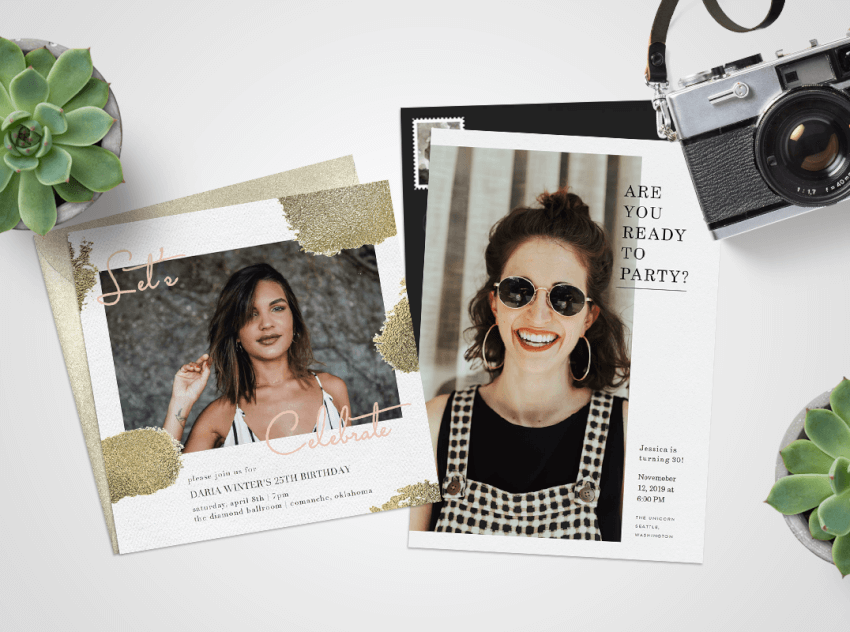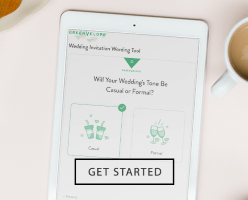How to Get Share-worthy Photos of Yourself for Invitations and Announcements

Do you love photo-insert designs but don’t always like photos of yourself? You’re not alone. And you don’t have to give up on that perfect invitation template either (trust us!) We’ve rounded up expert opinions from the best of the best for capturing photos. Keep scrolling to learn how you can snap share-worthy photos that you’ll be excited to share on an invitation (and everywhere else)!
Lighting, Lighting, Lighting.
Anyone who has ever been in an airport bathroom understands how important good lighting is to looking and feeling our best. Jokes aside, lighting is a top tip we received from every single expert. So, how can you find lighting that works in your favor? First, consider the mood you want to achieve.
“Directional lighting can create a moody, dramatic effect. However, the fail-safe lighting set-up for approachable portraits is to find soft, even lighting. This can be achieved in a studio with softboxes, but anyone with a window can also take great portraits with natural light—think soft morning light through a window, daytime lighting on an overcast day, or diffusing bright daytime light with sheer white curtains, ” says Jocelyn Voo of Everly Studios.
Style and beauty blogger, Shelby Tristin, explains, if you’re trying to achieve that Instagram glow, capture those photos at “golden hour,” or the time right before the sun sets. “You will notice a glow in your photos as long as you’re facing the sun.”
If you want to capture yourself outside on a sunny day, Antonina Mamzenko, award-winning family photographer, recommends posing under, “open shade, like a big old tree that stops the light from shining directly overhead, and facing outwards into the light.”
Nechama Leitner, who specializes in professional headshots and fashion photography, also says to consider that the sun bounces off lighter surfaces, which you can use to your advantage. For a headshot, “hold a paper, a white notebook, or a white bag under your chin and let the sun behind you bounce from the paper to your face.” In photography terms, this would be called a “reflector.” For any shots that aren’t close up, “find a light-colored building and let the sun bounce off the building and onto your face.”
Location
Keep lighting in mind for this next tip, which covers location. According to Leitner, places where you’re almost always guaranteed to find nice, soft lighting include: an alleyway, in front of a window, right in front of a doorway, and the entryway of any building that faces a light-colored building. In general, photos captured outside are often favorable. Whether you’re at the top of a mountain or on your neighbor’s patio, photos captured in the early morning light or on an overcast day will be most flattering.
Practice Makes Perfect
If your face freezes up like Chandler taking engagement photos every time a camera comes out, consider practicing ahead of time. Voo recommends, “if you’re camera shy, practice. Take a look at what kind of headshots or portraits you like of other people. Then, set the mood with some fun music, try on different outfits to see what colors work best, and mimic the different poses you like.”
Pose like a Pro
Posing can often feel like the most difficult part of taking photos. (What should I do with my hands?!) Don’t panic and keep a couple simple tips in mind. Voo explains, “In general, you’ll want to angle your body slightly away from the camera. Next, angle your face to catch the light. If you’re taking photos with a window as your light source, position yourself so your face is towards the light source, with your body angled slightly away. This reduces the shadows on your face, giving you a more even complexion.”
Dave Bowden, founder of Irreverent Gent, suggests a pre-photo warm up. “Before you take the picture, try holding a smile for 60 seconds, or watching a hilarious clip on YouTube that will make you belly laugh. Doing a full-on, face-forming smile or laughing naturally moves your face muscles into a position that conveys happiness, without you having to consciously force yourself to smile. Give yourself a brief second to come down after the peak state, then snap the picture. You’ll look like a naturally happy and optimistic person—without having to say ‘cheese.’”
Use the Tools you Have
In the past, if you wanted a high-quality photo, you needed an expensive camera. Now, phone cameras are able to take equally stunning photographs. If you know how to use the available features, your photos might even be mistaken for professional! “If you’re working with a smartphone a lot of them have incredibly advanced photo-taking features that you can maximize,” says Voo. “The iPhone, for instance, has Portrait mode, which utilizes dual in-phone cameras to give you that depth of field that DSLRs give. This can help draw the focus of the photo onto you, not the background, which is particularly helpful if your surrounding environment is a little cluttered or distracting.”
In addition to those built-in features, Elizabeth Williamsberg, a professional portrait and personal brand photographer, recommends one simple thing: zoom! “Whether you’re using your phone or a point-and-shoot camera, zoom in. Most phone camera apps shoot using a default setting that replicates a 35mm lens, which gives you a wide angle to allow for maximum background in the photo, but this comes at a cost—lens distortion. The wider the lens, the more distorted your face looks. When you use a point and shoot, the cameras generally start at 20mm – 35mm in their default setting, which also allows for the widest angle possible and makes everything look wider, including your face!”
More is More
The key to capturing that perfect photo of yourself? Dozens of photos that were a little less than perfect. Photographer Iain Irwin says, “No one will ever see the photographs you don’t like. Experiment with the light, try different poses, let out a fake laugh, whatever it is, give it a go! I might take 30 self portraits before I’m happy, but it doesn’t matter because nobody is ever going to see the ones I don’t like. Don’t be afraid to make a fool of yourself. You won’t get better if you don’t try. Just go and do it!” Mamzenko also recommends using the Burst Mode feature, which automatically takes a series of photos in quick succession.
Just Flip It
If you tend to dislike photos of yourself compared to what you see in the mirror, Williamsberg has an excellent explanation (and a tip to help!) “The number one tip I give combines both photography and psychology. Most people don’t have a perfectly symmetrical face. Because we most often see ourselves when we look at our reflection, our reflected face is how we internalize our self image, how we believe we should look. When we take an image with a camera, it shows us the true view, not the reflected image. Because our faces are not perfectly symmetrical, the resulting image looks weird to ourselves. My number one tip when taking a photo of yourself is to mirror the image. When you take a photo with your phone using the self-facing camera, the live view you see is mirrored, but then the phone automatically flips the image to not be backward, resulting in an image that looks fine to others but not to you. Use an app to flip the image back to backward. Adobe Photoshop Express has this feature and it’s super easy to use. In Edit mode, open your photo, select the Crop icon at the bottom of the screen, then select Rotate and click on “Flip Horizontal.” You will be surprised how much better an image of yourself looks to you with this one simple trick.”


